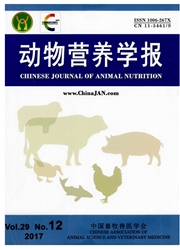

 中文摘要:
中文摘要:
本试验旨在对不同养殖模式、投喂不同饵料及不同品系大黄鱼的营养成分进行比较。试验选取东海区野生岱衢族大黄鱼(野生组)、投喂冰鲜鱼的池塘养殖岱衢族大黄鱼(池塘组)、投喂冰鲜鱼的深水网箱养殖岱衢族大黄鱼(深水网箱组)、投喂冰鲜鱼的网箱养殖岱衢族大黄鱼(冰鲜鱼组)、投喂人工配合饲料的网箱养殖岱衢族大黄鱼(饲料组)以及投喂冰鲜鱼的网箱养殖闽东族大黄鱼(闽东组)各6尾,对它们的形态学指标(肥满度、肝体指数和脏体指数,(n=6),背部、腹部肌肉及全鱼的常规营养成分(n=3)、氨基酸组成(n=3),背部肌肉脂肪酸组成(n=3)以及全鱼重金属(无机砷、铅、汞和镉)含量(n=3)进行比较分析。结果表明:1)野生组大黄鱼肥满度和肝体指数显著低于深水网箱组、池塘组以及冰鲜鱼组(P〈0.05),而不同养殖模式的各组之间肥满度和肝体指数差异不显著(P〉0.05);饲料组大黄鱼脏体指数显著低于冰鲜鱼组和闽东组(P〈0.05)。2)野生组大黄鱼背部、腹部肌肉粗脂肪含量最低,但与饲料组差异不显著(P〉0.05);大黄鱼背部、腹部肌肉及全鱼粗蛋白质含量均以野生组、冰鲜鱼组和饲料组较高,且这3组之间差异不显著(P〉0.05);大黄鱼背部、腹部肌肉粗灰分含量各组间差异不显著(P〉0.05)。3)野生组、冰鲜鱼组和饲料组大黄鱼背部、腹部肌肉及全鱼氨基酸总量、必需氨基酸总量、呈味氨基酸总量、鲜味氨基酸总量均高于池塘组、深水网箱组和闽东组。4)野生组、饲料组与深水网箱组大黄鱼背部肌肉脂肪酸总量、不饱和脂肪酸总量和高不饱和脂肪酸总量高于冰鲜鱼组、池塘组和闽东组,其中背部肌肉脂肪酸总量和不饱和脂肪酸总量均以闽东组最低。5)野生组大黄鱼全鱼汞含量较高,饲?
 英文摘要:
英文摘要:
This study was conducted to compare the nutrient components of large yellow croaker ( Pseudosciae- na crocea Richardson) cultured in different modes fed different feeds and from different strains. Six wild Daiqu strain large yellow croaker captured in East China Sea ( wild group), 6 Daiqu strain large yellow croak- er cultured in pond which fed frozen fresh fish (pond group), 6 Daiqu strain large yellow croaker cultured in deep-water net cage which fed frozen fresh fish ( deep-water net cage group), 6 Daiqu strain large yellow croaker cultured in net cage which fed frozen fresh fish (frozen fresh fish group), 6 Daiqu strain large yellow croaker cultured in net cage which fed artificial compound feed ( feed group), and 6 Mindong satin large croaker yellow cultured in net cage which fed frozen fresh fish (Mindong group) were selected to analyze and compare the morphological indices (condition factor, viscerosomatic index and hepatosomatic index, n = 6 ), common nutrient components (n = 3 ) and amino acid composition in back muscle, abdominal muscle and whole body (n = 3 ), fatty acid composition in back muscle (n = 3 ), and heavy metal (inorganic arsenic, mercury, plumbum and chromium) contents in whole body (n = 3 ). The results showed as follows: 1 ) the condition factor and hepatosmatic index of large yellow croaker in wild group were significantly lower than those in deep-water net cage group, pond group and frozen fresh fish group ( P 〈 0.05 ), while the condition factor and hepatosmatic index were not significantly different among groups cultured in different modes (P 〉 0.05 ) ; the viscerosomatic index in feed group was significantly lower than that in frozen fresh fish group and Mindong group ( P 〈 0.05 ). 2 ) The crude lipid content in back muscle and abdominal muscle of large yellow croaker in wild group was the lowest, but no significant difference was found between wild group and feed group ( P 〉 0.05 ) ; the crude protein
 同期刊论文项目
同期刊论文项目
 同项目期刊论文
同项目期刊论文
 期刊信息
期刊信息
